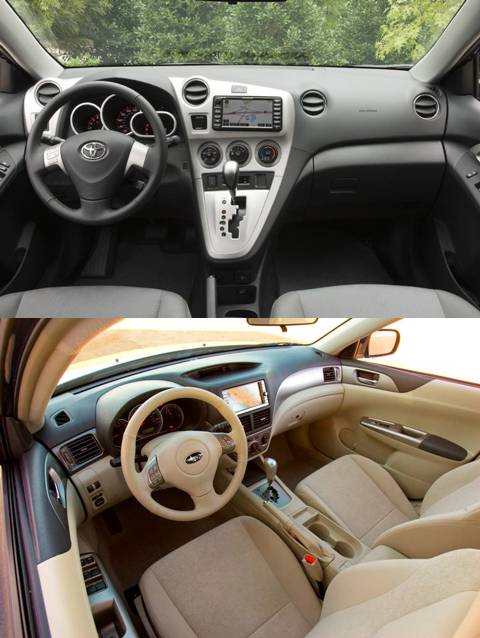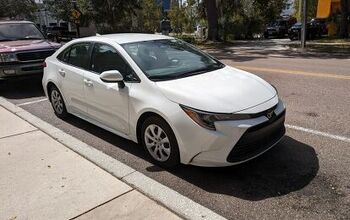2009 Toyota Matrix S AWD Vs. 2008 Subaru Impreza 2.5i 5-Door
At some point in our recent automotive history, all wheel-drive (AWD) replaced front wheel-drive as the paranoid consumer's drivetrain of choice. The safety advantages of high quality snow tires (as needed) and a low center of gravity (in all cases) got lost in translation. Ready to capitalize on the AWD's popularity: the economy-oriented Toyota Matrix and the Subaru Impreza. Both diminutive scramblers aren't nearly as cheap or efficient as their front-wheel-drive cousins, and they won't off-road, tow a boat or carry seven passengers. Still, both cars offer a [potential] extra safety margin and [potentially] better handling. So if you had to choose one…
The Impreza and the Matrix were both recently restyled. The new Matrix looks like it's been hanging in Beverly Hills. And yet, even after a nip, tuck, stretch and smooth, the Matrix' bloated-Yaris profile remains. Though the car's tighter greenhouse and diving roof line improve on the prior model's anodyne anonymity, form comes at the expense of function (more on that later).
The Impreza hatch's-sorry, "5-Door's" restyle offers a sleek, ovoid look that's both familiar and jarring. Subaru achieved this paradox by littering a restrained, attractive shape with unnecessary, eye-melting flourishes (e.g. icicle taillights, and faux-Chrysler pilot wings on the grille). Select the "sports grille" option and plain black mesh replaces your slice of plastic corporate flair, transforming the Impreza's styling. If only Subaru offered a "tasteful tail light" option…
The Matrix' one-box (one-trapezoid?) design creates a minivan-in-a-trash-compacter interior vibe (so to speak). The steep windshield and short hood enable acceptable forward vision. But the Toyota's sharply-falling roof and gun-slit windows are insupportable, they put the words "oh shit!" into "blind spot." The Matrix boasts slightly more cargo capacity than the Impreza, but the Yaris provides more hip room.
The Impreza's rearward vision is also curtailed by its sloping roofline, but at least you can check your blind spots without a periscope. Although the Subie is slightly smaller than the Matrix by most metrics– including the vital rear leg room calculation– its airy greenhouse is far more inviting than the Toyota's four-wheeled bunker.
Let's face it: adult-sized adults won't want to spend an inordinate amount of time in either back seat.
The Matrix's clean, unpretentious interior styling emphasizes function. A pervasive sense of cheapness and fragility prevents its cabin from achieving rugged or utilitarian props. The Toyota's black cockpit is brightened only by acres of the hard, shiny silver plastic that ToMoCo owners have come to know and abhor. By the same token, while the Matrix' large climate control knobs are paragons of simplicity, they're imprecise and poorly secured to the minivan-style console.
The beige-and-black Subaru four-door's interior plastics seem like close relatives of the trailer trash found in the Toyota's cockpit. Other materials are of a noticeably higher quality. And while the two-dimensional Toyota cockpit embraces appliance-dom, the Subaru wraps its occupants in a low-rent take on the BMW driver-oriented interior. If you like the Impreza's sheetmetal, the interior styling won't jar. If not, you'll find it boring, garish or (once again) both.
The AWD Matrix comes in one drivetrain flavor: a 2.4-liter inline four-cylinder engine with a four-speed automatic transmission. Pop it in "D," arrange a sour expression on your face, mash the gas and the 158hp mill will hustle the portly (3360 lbs) Matrix about with joyless adequacy. The quadra-geared slushbox helps keep fun at bay, but doesn't display the manic thrash that Berkowitz experienced with Toyota's five-speed unit (available on non-AWD Matrices).
The drivetrain's misère de vivre is a blessing in disguise; you weren't going to have fun driving the Matrix anyway. Unmanned aerial drones offer more steering feedback than the Toyota's over-boosted helm. The Matrix' pillow-soft suspension upholds this commitment to sensory deprivation. Body roll and understeer quickly define the limits of cornering ability (or lack thereof). That the AWD Matrix gets standard double wishbone rear suspension is more indicative of Toyota's product-packaging strategy than any corner-carving aptitude.
The Impreza has let itself go lately. It's packed on nearly 250 pounds compared to its autocross-dominating 2.5 RS nineties forbears. However, compared to the overfed, over-medicated Matrix, the AWD Subaru is a well-trained athlete. The trademark 2.5-liter boxer four marries 170hp with handfuls of usable torque, requiring only minimal use of the agricultural five-speed stick. Though crunchy and imprecise, the manual makes far better use of the Subie's burble 'n snarl than the lugging, laggy autobox. Both transmissions have their flaws, but it's nice to have a choice (Toyota).
No question: the Impreza's mainstream makeover has dumbed-down the car's handling. With added weight and softer springs, the Scooby tends to lean and hunt for its line, when it should be darting and planting. The payoff: serenity at speed. What the Impreza surrenders in autocrossmanship it makes up for on long trips to the cabin or trailhead.
This is not to say the Impreza is corner-aversive. The Impreza's steering is far more engaging than the Matrix'; the Subaru's helm delivers solid heft and remains in constant communication with the chassis. When the going gets curvy, the Impreza's full-time all wheel-drive routes more power to the rear wheels, allowing the Impreza to power through corners in an entirely pleasant point-and-shoot style.
In stark contrast, the Toyota system displays no hint of AWD hoonery. It only sends power to the Matrix' rear wheels when the front tires start to slip. Unless you regularly drive on dirt or gravel, you might never notice the Toyota AWD engage. Clearly, it's not an integral feature.
In sum, the AWD Matrix is the weakest offering in the Corolla/Matrix range. Nearly all the other cars are cheaper, lighter and more efficient than the AWD variant-and the Impreza. At $21,060 for a base AWD Matrix, it's well inside just-say-no territory. Especially with the $18,640 Impreza nipping at its heels.
With neither the Matrix nor the Impreza claiming a decisive EPA ratings victory (at 20/26 and 20/27 respectively), the Impreza's price point is the game-winner here. And if driving pleasure is even remotely important, the Matrix fails miserably, while the Impreza scores impressively.
Subaru's decision to take the Impreza mainstream didn't win praise from the brand faithful. But it widened the mini-wagon's distance from its competition. The only thing standing in the Impreza's path to segment dominance: mileage (back to that front wheel-drive equation). And the new, all wheel-drive Suzuki SX4, which takes the cheap-and-cheerful approach once espoused by the 'Preza. Having dispatched the Matrix AWD, we'll let you know how the Subie and the Suzi measure-up.
More by Edward Niedermeyer
Latest Car Reviews
Read moreLatest Product Reviews
Read moreRecent Comments
- FreedMike I would find it hard to believe that Tesla spent time and money on developing a cheaper model, only to toss that aside in favor of a tech that may or may not ever work right. Having said that, though, I think what's happening with Tesla is something I've been predicting for a long time - they have competition now. That's reflected in their market share. Moreover, their designs are more than a bit stale now - the youngest model is the Model Y, which is in its' fifth model year. And it's hard to believe the Model 3 is in its' seventh model year. Aside from an interior restyle on the Model 3, neither of those cars looks substantially different than they did when they came on the market. And you can also toss in Tesla's penchant for unnecessary weirdness as a liability - when the Model 3 and Y were introduced, there was no real competition for either, so people had to put up with the ergonomic stupidity and the weird styling to get an electric compact sedan or crossover. Today, there's no shortage of alternatives to either model, and while Tesla still holds an edge in battery and EV tech, the competition is catching up. So...a stale model lineup, acceptable alternatives...and Elon Musk's demon brain (the gift that keeps on giving), All that has undercut their market share, and they have to cut prices to stay competitive. No wonder they're struggling. Solution? Stop spending money on tech that may never work (cough...FSD) and concentrate on being a car company.
- EBFlex “Tesla’s first-quarter net income dropped a whopping 55 percent”That’s staggering and not an indicator of a market with insatiable demand. These golf cart manufacturers are facing a dark future.
- MrIcky 2014 Challenger- 97k miles, on 4th set of regular tires and 2nd set of winter tires. 7qts of synthetic every 5k miles. Diff and manual transmission fluid every 30k. aFe dry filter cone wastefully changed yearly but it feels good. umm. cabin filters every so often? Still has original battery. At 100k, it's tune up time, coolant, and I'll have them change the belts and radiator hoses. I have no idea what that totals up to. Doesn't feel excessive.2022 Jeep Gladiator - 15k miles. No maintenance costs yet, going in for my 3rd oil change in next week or so. All my other costs have been optional, so not really maintenance
- Jalop1991 I always thought the Vinfast name was strange; it should be a used car search site or something.
- Theflyersfan Here's the link to the VinFast release: https://vingroup.net/en/news/detail/3080/vinfast-officially-signs-agreements-with-12-new-dealers-in-the-usI was looking to see where they are setting up in Kentucky...Bowling Green? Interesting... Surprised it wasn't Louisville or Northern Kentucky. When Tesla opened up the Louisville dealer around 2019 (I believe), sales here exploded and they popped up in a lot of neighborhoods. People had to go to Indy or Cincinnati/Blue Ash to get one. If they manage to salvage their reputation after that quality disaster-filled intro a few months back, they might have a chance. But are people going to be willing to spend over $45,000 for an unknown Vietnamese brand with a puny dealer/service network? And their press photo - oh look, more white generic looking CUVs. Good luck guys. Your launch is going to have to be Lexus in 1989/1990 perfect. Otherwise, let me Google "History of Yugo in the United States" as a reference point.






































Comments
Join the conversation
I purchased a 2010 Matrix XR AWD based on the following facts: - Toyota has an ubeatable durability/reliabilty record, and a stronger dealership network; - Subaru's rust easier/faster than Toyota's; - Subaru's parts generally cost more; - Subaru's are more expensive to insure (in Canada anyway); (maybe because of all the boy racer's out there driving Impreza's, lol) - Impreza seating/ ground clearance too low; - Impreza has to be one of the ugliest vehicles on the road; So, to recap, it's not so much how Totota won me over, but rather how Subaru has turned me off. I also tested the Suzuki SX4 - small trunk space & small gas tank were deal breakers for me...
I drove a Matrix whilst my other car (a BMW, of course) was in the shop... My impression of the Matrix: cheap interior and horrible gas mileage (average of 20 mpg). My Subaru, in contrast, gets 23 to 33 mpg, and the interior, while cheap, is not repulsive and toy-like and fragile-feeling, which is how the Matrix interior felt. Both accelerate okay and both cars handle acceptably... but $23,000 for a loaded Matrix?!! No way!